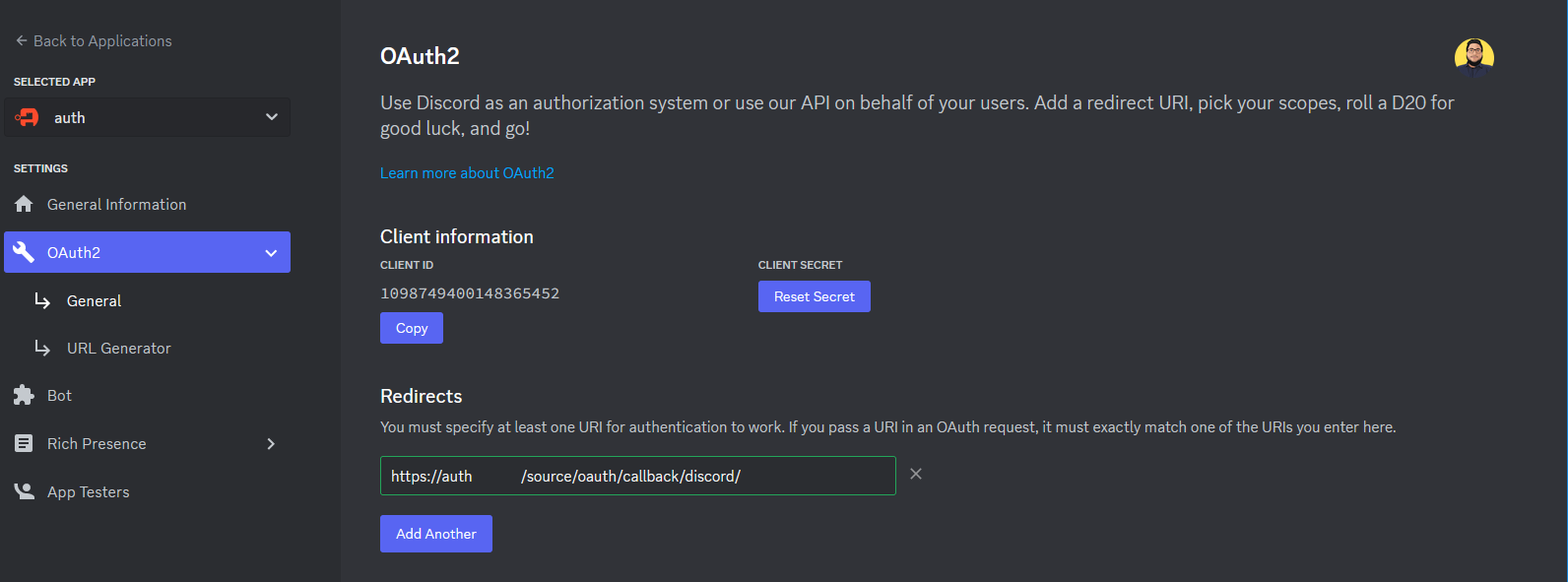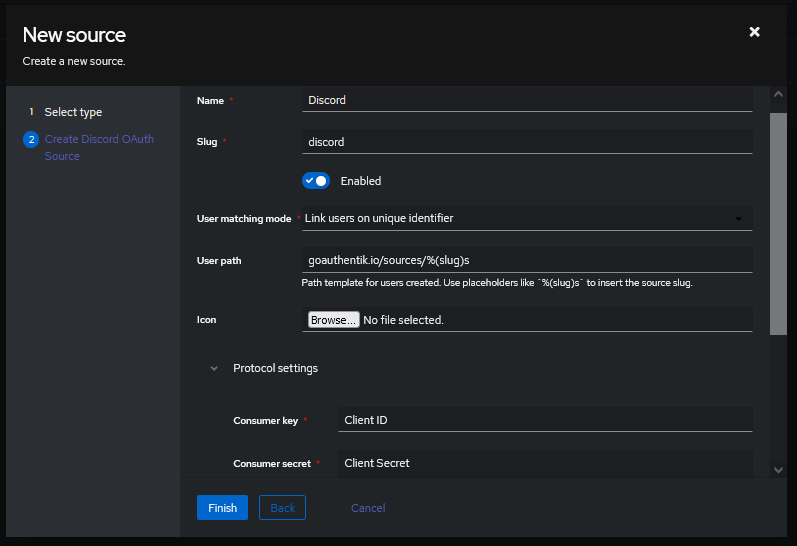Discord
Support level: authentik
Allows users to authenticate using their Discord credentials
Preparation
The following placeholders are used in this guide:
authentik.companyis the FQDN of the authentik installation.
Discord
- Create an application in the Discord Developer Portal (This is Free) https://discord.com/developers/applications

- Name the Application

-
Select OAuth2 from the left menu
-
Copy the Client ID and save it for later
-
Click to Reveal the Client Secret and save it for later
-
Click Add Redirect and add https://authentik.company/source/oauth/callback/discord/
Here is an example of a completed OAuth2 screen for Discord.

authentik
-
Under Directory -> Federation & Social login Click Create Discord OAuth Source
-
Name: Choose a name (For the example I used
Discord) -
Slug: discord (You can choose a different slug, if you do you will need to update the Discord redirect URL and point it to the correct slug.)
-
Consumer Key: Client ID from step 4
-
Consumer Secret: Client Secret from step 5
Here is an example of a complete authentik Discord OAuth Source

Save, and you now have Discord as a source.
For more details on how-to have the new source display on the Login Page see here.
Checking for membership of a Discord Guild
Ensure that the Discord OAuth source in Federation & Social login has the additional guilds guilds.members.read scopes added under Protocol settings.
Create a new Expression Policy with the content below, adjusting the variables where required:
# To get the guild ID number for the parameters, open Discord, go to Settings > Advanced and enable developer mode.
# Right-click on the server/guild title and select "Copy ID" to get the guild ID.
ACCEPTED_GUILD_ID = "123456789123456789"
GUILD_NAME_STRING = "The desired server/guild name in the error message."
# Only change below here if you know what you are doing.
# Ensure flow is only run during OAuth logins via Discord
if context['source'].provider_type != "discord":
return True
# Get the user-source connection object from the context, and get the access token
connection = context.get("goauthentik.io/sources/connection")
if not connection:
return False
access_token = connection.access_token
guilds = requests.get(
"https://discord.com/api/users/@me/guilds",
headers= {
"Authorization": f"Bearer {access_token}",
}
).json()
user_matched = any(ACCEPTED_GUILD_ID == g["id"] for g in guilds)
if not user_matched:
ak_message(f"User is not a member of {GUILD_NAME_STRING}.")
return user_matched
Now bind this policy to the chosen enrollment and authentication flows for the Discord OAuth source.
Checking for membership of a Discord Guild role
Ensure that the Discord OAuth source in Federation & Social login has the additional guilds guilds.members.read scopes added under Protocol settings.
Create a new Expression Policy with the content below, adjusting the variables where required:
# To get the role and guild ID numbers for the parameters, open Discord, go to Settings > Advanced and
# enable developer mode.
# Right-click on the server/guild title and select "Copy ID" to get the guild ID.
# Right-click on the server/guild title and select server settings > roles, right click on the role and click
# "Copy ID" to get the role ID.
ACCEPTED_ROLE_ID = "123456789123456789"
ACCEPTED_GUILD_ID = "123456789123456789"
GUILD_NAME_STRING = "The desired server/guild name in the error message."
ROLE_NAME_STRING = "The desired role name in the error message."
# Only change below here if you know what you are doing.
GUILD_API_URL = f"https://discord.com/api/users/@me/guilds/{ACCEPTED_GUILD_ID}/member"
# Ensure flow is only run during OAuth logins via Discord
if context['source'].provider_type != "discord":
return True
# Get the user-source connection object from the context, and get the access token
connection = context.get("goauthentik.io/sources/connection")
if not connection:
return False
access_token = connection.access_token
guild_member_object = requests.get(
GUILD_API_URL,
headers= {
"Authorization": f"Bearer {access_token}",
}
).json()
# The response for JSON errors is held within guild_member_object['code']
# See: https://discord.com/developers/docs/topics/opcodes-and-status-codes#json
# If the user isn't in the queried guild, it gives the somewhat misleading code = 10004.
if "code" in guild_member_object:
if guild_member_object['code'] == 10004:
ak_message(f"User is not a member of {GUILD_NAME_STRING}.")
else:
ak_create_event("discord_error", source=context['source'], code=guild_member_object['code'])
ak_message("Discord API error, try again later.")
# Policy does not match if there is any error.
return False
user_matched = any(ACCEPTED_ROLE_ID == g for g in guild_member_object["roles"])
if not user_matched:
ak_message(f"User is not a member of the {ROLE_NAME_STRING} role in {GUILD_NAME_STRING}.")
return user_matched
Now bind this policy to the chosen enrollment and authentication flows for the Discord OAuth source.
Syncing Discord roles to authentik groups
Ensure that the Discord OAuth source in Federation & Social login has the additional guilds.members.read scopes added under Protocol settings.
Any authentik role that you want to sync with a Discord role needs to have the attribute discord_role_id with a value of the Discord role's ID set.
This setting can be found under Authentik > Admin Interface > Directory > Groups > YOUR_GROUP > Attributes
Example: discord_role_id: "<ROLE ID>"
The following two policies allow you to synchronize roles in a Discord guild with roles in authentik.
Whenever a user enrolls or signs in to authentik via a Discord source, these policies will check the user's Discord roles and apply the user's authentik roles accordingly.
All roles with the attribute discord_role_id defined will be added or removed depending on whether the user is a member of the defined Discord role.
Create a new Expression Policy with the content below, adjusting the variables where required.
Sync on enrollment
The following policy will apply the above behaviour when a user enrolls.
from authentik.core.models import Group
GUILD_API_URL = "https://discord.com/api/users/@me/guilds/{guild_id}/member"
### CONFIG ###
guild_id = "<YOUR GUILD ID>"
##############
# Ensure flow is only run during OAuth logins via Discord
if context["source"].provider_type != "discord":
return True
# Get the user-source connection object from the context, and get the access token
connection = context.get("goauthentik.io/sources/connection")
if not connection:
return False
access_token = connection.access_token
guild_member_request = requests.get(
GUILD_API_URL.format(guild_id=guild_id),
headers={
"Authorization": f"Bearer {access_token}",
},
)
guild_member_info = guild_member_request.json()
# Ensure we are not being ratelimited
if guild_member_request.status_code == 429:
ak_message(f"Discord is throttling this connection. Retry in {int(guild_member_info['retry_after'])}s")
return False
# Ensure user is a member of the guild
if "code" in guild_member_info:
if guild_member_info["code"] == 10004:
ak_message("User is not a member of the guild")
else:
ak_create_event("discord_error", source=context["source"], code=guild_member_info["code"])
ak_message("Discord API error, try again later.")
return False
# Get all discord_groups
discord_groups = Group.objects.filter(attributes__discord_role_id__isnull=False)
# Filter matching roles based on guild_member_info['roles']
user_groups_discord_updated = discord_groups.filter(attributes__discord_role_id__in=guild_member_info["roles"])
# Set matchin_roles in flow context
request.context["flow_plan"].context["groups"] = user_groups_discord_updated
# Create event with roles added
ak_create_event(
"discord_role_sync",
user_discord_roles_added=", ".join(str(group) for group in user_groups_discord_updated),
)
return True
Now bind this policy to the chosen enrollment flows for the Discord OAuth source.
Sync on authentication
The following policy will apply the above behaviour when a user logs in.
from authentik.core.models import Group
GUILD_API_URL = "https://discord.com/api/users/@me/guilds/{guild_id}/member"
### CONFIG ###
guild_id = "<YOUR GUILD ID>"
##############
# Ensure flow is only run during OAuth logins via Discord
if context["source"].provider_type != "discord":
return True
# Get the user-source connection object from the context, and get the access token
connection = context.get("goauthentik.io/sources/connection")
if not connection:
return False
access_token = connection.access_token
guild_member_request = requests.get(
GUILD_API_URL.format(guild_id=guild_id),
headers={
"Authorization": f"Bearer {access_token}"
},
)
guild_member_info = guild_member_request.json()
# Ensure we are not being ratelimited
if guild_member_request.status_code == 429:
ak_message(f"Discord is throttling this connection. Retry in {int(guild_member_info['retry_after'])}s")
return False
# Ensure user is a member of the guild
if "code" in guild_member_info:
if guild_member_info["code"] == 10004:
ak_message("User is not a member of the guild")
else:
ak_create_event("discord_error", source=context["source"], code=guild_member_info["code"])
ak_message("Discord API error, try again later.")
return False
# Get all discord_groups
discord_groups = Group.objects.filter(attributes__discord_role_id__isnull=False)
# Split user groups into discord groups and non discord groups
user_groups_non_discord = request.user.ak_groups.exclude(pk__in=discord_groups.values_list("pk", flat=True))
user_groups_discord = list(request.user.ak_groups.filter(pk__in=discord_groups.values_list("pk", flat=True)))
# Filter matching roles based on guild_member_info['roles']
user_groups_discord_updated = discord_groups.filter(attributes__discord_role_id__in=guild_member_info["roles"])
# Combine user_groups_non_discord and matching_roles
user_groups_updated = user_groups_non_discord.union(user_groups_discord_updated)
# Update user's groups
request.user.ak_groups.set(user_groups_updated)
# Create event with roles changed
ak_create_event(
"discord_role_sync",
user_discord_roles_before=", ".join(str(group) for group in user_groups_discord),
user_discord_roles_after=", ".join(str(group) for group in user_groups_discord_updated),
)
return True
Now bind this policy to the chosen authentication flows for the Discord OAuth source.
Store OAuth info in attribute and create avatar attribute from Discord avatar
Ensure that the Discord OAuth source in Federation & Social login has the additional guilds.members.read scopes added under Protocol settings.
In order to use the created attribute in authentik you will have to set authentik configuration arguments found at: https://docs.goauthentik.io/docs/core/settings#avatars
Create a new Expression Policy with the content below, adjusting the variables where required:
import base64
import requests
AVATAR_SIZE = "64" # Valid values: 16,32,64,128,256,512,1024. Larger values may cause HTTP error 431 on applications/providers due to headers being too large.
# Only change below here if you know what you are doing.
AVATAR_URL = "https://cdn.discordapp.com/avatars/{id}/{avatar}.png?size={avatar_size}"
AVATAR_STREAM_CONTENT = "data:image/png;base64,{base64_string}" # Converts base64 image into html syntax usable with authentik's avatar attributes feature
def get_as_base64(url):
"""Returns the base64 content of the url"""
return base64.b64encode(requests.get(url).content)
def get_avatar_from_avatar_url(url):
"""Returns an authentik-avatar-attributes-compatible string from an image url"""
cut_url = f"{url}"
return AVATAR_STREAM_CONTENT.format(
base64_string=(get_as_base64(cut_url).decode("utf-8"))
)
# Ensure flow is only run during OAuth logins via Discord
if context["source"].provider_type != "discord":
return True
user = request.user
userinfo = request.context["oauth_userinfo"]
# Assigns the discord attributes to the user
user.attributes["discord"] = {
"id": userinfo["id"],
"username": userinfo["username"],
"discriminator": userinfo["discriminator"],
"email": userinfo["email"],
"avatar": userinfo["avatar"],
"avatar_url": (
AVATAR_URL.format(
id=userinfo["id"], avatar=userinfo["avatar"], avatar_size=AVATAR_SIZE
)
if userinfo["avatar"]
else None
),
}
# If the user has an avatar, assign it to the user
avatar_url = user.attributes["discord"].get("avatar_url", None)
if avatar_url is not None:
user.attributes["avatar"] = get_avatar_from_avatar_url(avatar_url)
user.save()
return True
Now bind this policy to the chosen enrollment and authentication flows for the Discord OAuth source.